




















Tuning Your Kit for High Wind
Source: Carbon Sugar
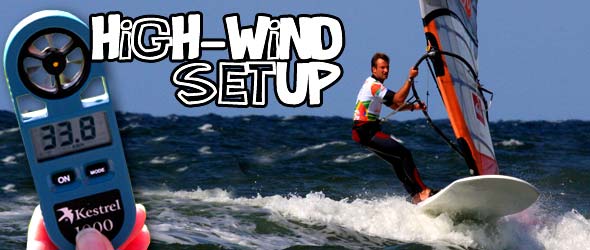
High wind Formula racing! It doesn’t get any more exciting, challenging, fulfilling and hardcore than that! With class rules that allow the Formula boards to be raced in up to 35 knots, its important that regular racers learn the do's and do not's of setting up their equipment to stay in control in high winds. Here we will discuss different tuning ideas and suggestions to get the most out of your equipment as well as sharing some secrets that most sailors wouldn't know that the pros are doing to keep their gear on the water and going fast.
- Downhaul Settings
- Outhaul Settings
- Batten Tuning
- Board Setup
- Boom Setup
- Technique
1. Downhaul Settings:
All formula sails work best when rigged to the specs on the sail using the correct mast for that sail (except of course when brands print the incorrect sail specs!). In the case of strong winds, it usually is ok to pull on an extra 2-3mm downhaul but very rarely does it help to pull on more than this!
- A sail which is underdownhauled is unstable, heavy, has no acceleration, feels sluggish and creates a lot of backhand pressure which often creates a lot of spinout on your fin due to the draft being too far back.
- An overdownhauled sail on the other hand becomes twitchy, unstable, unable to point and feels unresponsive.
Although the tendency for the guys who've joined the formula racing from years of slalom racing is to just pull more downhaul, once you've exceeded the max-downhaul point for your sail you are actually making it more difficult by pulling more downhaul. Overdownhauling your sail can do two things; 1) release the pressure on the nose of your board, making the board fly out of the water and 2) make the sail feel very twitchy and unstable in your hands.
If you are using a widesleeve modern sail, look at the two battens above and below the boom when rigging. If either of these is 's' bending towards the luff then you are most likely using too much downhaul.
For the best performance, rig your sail to specs and work on the next 5 points to get control of your gear; downhaul is probably the last thing you should resort to in strong winds.
2. Boom Settings:
OUTHAUL:
Outhaul plays a MAJOR role in control in high winds. Put your boom out an extra hole (or two) and make sure your outhaul lines are setup that you can pull a lot of outhaul on. There is a point you will reach that you will start to lose angle with this amount of outhaul pulled on but it will give you control. As you improve, you can start to use less outhaul in the same winds which will give you better angle. See the Batten Tuning section below for more ideas on improving your use of outhaul for control.
HARNESS LINES:
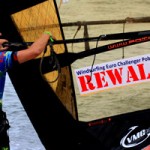 Longer harness lines will help in strong winds. Most top sailors are using fixed lines despite the popularity of adjustable lines in different styles of windsurfing such as RS:X and slalom. A good option is to run adjustable lines that stay relatively fixed (ie, are hard to adjust on the fly) as these can be adjusted in between races on the beach fairly easily but still are stiff enough to not slip during races and become too long. A good example is the Neilpryde Adjustable harness lines which are extremely difficult to adjust on the water without breaking the clips, but stay in the length you adjust them to forever if you change them on the beach.
Longer harness lines will help in strong winds. Most top sailors are using fixed lines despite the popularity of adjustable lines in different styles of windsurfing such as RS:X and slalom. A good option is to run adjustable lines that stay relatively fixed (ie, are hard to adjust on the fly) as these can be adjusted in between races on the beach fairly easily but still are stiff enough to not slip during races and become too long. A good example is the Neilpryde Adjustable harness lines which are extremely difficult to adjust on the water without breaking the clips, but stay in the length you adjust them to forever if you change them on the beach.
BOOM HEIGHT:
This is an interesting one. A lot of people advise lowering the boom in strong winds for control. This is a technique used in slalom boards where you are not relying on fin and rail pressure to the extent we are on formula boards. Lowering your booom 1-2cm may help for control, but lowering it any more than 1-2cm will actually make sailing more difficult!
Why, you ask?
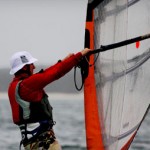 Lowering the boom shortens the triangle you make between your boom, your arms holding the boom and your legs touching the board. This is the centre of lateral resistance and effects your power-to-weight ratio on a board. A heavier, taller sailor with longer arms, will usually be much faster and more in control in high winds (if all equipment and skill levels are the same). By lowering the boom you are reducing the amount of leverage you have on the board and it actually makes it more difficult to hold on to the sail in strong winds believe it or not. It is liken to the effect of using a board with a smaller tail in high winds, you don't get the same leverage which makes holding the rig down much easier.
Lowering the boom shortens the triangle you make between your boom, your arms holding the boom and your legs touching the board. This is the centre of lateral resistance and effects your power-to-weight ratio on a board. A heavier, taller sailor with longer arms, will usually be much faster and more in control in high winds (if all equipment and skill levels are the same). By lowering the boom you are reducing the amount of leverage you have on the board and it actually makes it more difficult to hold on to the sail in strong winds believe it or not. It is liken to the effect of using a board with a smaller tail in high winds, you don't get the same leverage which makes holding the rig down much easier.
3. Batten Tuning:
This may suprise a lot of people, but many top pros are doing some tricky things with their battens to give them more control in stronger winds and sometimes allow them to hang on to a bigger rig than others out on the course.
When you get very overpowered, most people's tendency is to pull on a lot of outhaul. This moves the drive of the sail further back which can sometimes make you lose angle upwind and make your sail feel very twitchy. Although most of us would happily exchange a little angle to gain some control, on certain sails it is possible to have both!
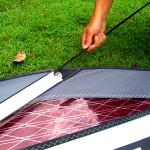 Find a piece of 8mm tube batten around 40-60cm long. 8mm is the same diameter as the large section (the opposite end to the thin tip section). Push this piece of batten in to the batten pocket above the boom whilst still having the original batten in place. With a bit of effort, there is usually enough room to get both pieces in to the batten pocket.
Find a piece of 8mm tube batten around 40-60cm long. 8mm is the same diameter as the large section (the opposite end to the thin tip section). Push this piece of batten in to the batten pocket above the boom whilst still having the original batten in place. With a bit of effort, there is usually enough room to get both pieces in to the batten pocket.
What this does is stiffen the back section of your sail dramatically, which keeps the draft forward on your sail and gives you much more stability. More stability means you might be able to sail in strong winds with the outhaul pulled on only 90%, not 100%!
Generally speaking this is only necessary in some brands of sails. From our experience, Neilpryde and Point-7 sails which have more luff curve than other brands have more neutral back hand pressure and probably wouldn't benefit from this extra batten. Gaastra, North, MauiSails and Severne sails which have a less radical luff shape would be better suited to this idea.
For extra stability you can even add this extra batten to the batten below the boom; with two extra battens in (above and below the boom) you get very good stability in the top end of the windrange however you may lose some sail shape in light winds, so remember to take them out on the light wind days.
4. Board Setup:
MAST TRACK:
The best thing you can do in strong winds which will help the most is to move your track forward. Usually more wind means more waves/chop and much more fin pressure, so the nose of your board will usually start to lift and that's where you can get in to trouble. Move your track 1-3cm forward and test your board once again. If you can hold it down, keep it there, if not, try it even more forward. Don't be afraid to move the track all the way to the front, if that is the only way you can keep your board down, then go for it.
Note that the further you move your track forward the harder it is to sail downwind sometimes. This is because with the track all the way forward the nose keeps very flat and downwind in chop it can be harder to get the nose clear of the waves to stop it catching. It is usually much better to be in control upwind rather than downwind in strong winds as there are features on the board that can help with the downwind more than upwind (see below).
FOOTSTRAPS:
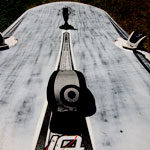 Try running your back footstraps a little looser. This will allow you to get your foot much deeper in to the strap which is the equivalent of having a footstrap 5cm further in to towards the middle of the board. If you can't handle downwind in the outside strap then get in to the chicken strap…
Try running your back footstraps a little looser. This will allow you to get your foot much deeper in to the strap which is the equivalent of having a footstrap 5cm further in to towards the middle of the board. If you can't handle downwind in the outside strap then get in to the chicken strap…
…in high winds you should ALWAYS run a chicken strap. Even if your board is comfortable and your skill level is up to allow you to sail downwind without it (which is usually faster), it's nice to have one on for the time in between races where you are cruising around; it saves quite a bit of energy.
Find a nice light strap and make sure it is SUPER tight. Having a loose strap for a chicken strap is counter productive as you don't want your foot completely flat on the back of the board. It is much better to be on the balls of your feet so you can control the railing of your board to help dodge rogue swells and compensate when you get out of control. The tighter you have your chicken strap the more control you have of your board; aim to only have the beginning of your arch in the strap, not your entire foot.
 Even better than a chicken strap is a DOUBLE CHICKEN STRAP. These were made popular by the Mike's Labs boards in San Francisco, whose owners were used to racing in the strong winds and vicious chop of the Bay area. A double chicken strap allows you to have a strap closer to half way between the outside strap and the centre of your board instead of just being in the middle. This gives the best placement for leverage and control whereas in the middle like a normal chicken strap is a little bit unbalanced.
Even better than a chicken strap is a DOUBLE CHICKEN STRAP. These were made popular by the Mike's Labs boards in San Francisco, whose owners were used to racing in the strong winds and vicious chop of the Bay area. A double chicken strap allows you to have a strap closer to half way between the outside strap and the centre of your board instead of just being in the middle. This gives the best placement for leverage and control whereas in the middle like a normal chicken strap is a little bit unbalanced.
The new 2010 Exocet and JP FW boards have a double chicken strap feature which is sure to be very popular as it also means the chicken strap can be utilised in much lighter winds as it can sometimes be more effective. Traditionally most other brands have shied away from double chicken straps as it means extra plugs need to be built in to the board which adds weight (as does the extra strap).
BOARD CHOICE:
Sorry to break it to everyone but there are certain boards which are designed for high winds better than others. As a 'general' guide, here are the boards we've found to be the best in stronger winds:
- Gaastra Vapor (all versions)
- Starboard LWR
- Exocet Warp (2010)
- JP 100 Pro
- Starboard F159, F160 and F161
These boards usually have a combination of vee the length of the board (often all the way to the finbox), wide tails for leverage and concaves to give a smoother ride over the swells. The nose shape also plays a role in a boards abilities in strong winds; all these boards have nose shapes designed to handle strong winds and chop very easily.
5. Fins:
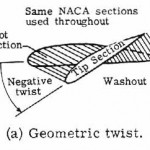 Fins play a bigger role than anyone could imagine. It is simply not as simple as saying "I should use a smaller fin" when you go out in strong winds.
Fins play a bigger role than anyone could imagine. It is simply not as simple as saying "I should use a smaller fin" when you go out in strong winds.
You should pay much more attention to the characteristics of fins. A great high wind fin will have a lot of 'twist' in the tip. Twist allows the fin to depower when it gets overloaded. Much like the leech of a sail spills off the power in a gust, the tip of the fin spills off the power and stops you getting out of control. The more twist you have in a fin, usually the more controllable it is in high winds if the foil is working, however it is then at the expense of angle upwind if you have too much twist.
Raking your fin (less upright) also helps create more 'geometric twist' in a fin, however having a more upright fin will keep the nose of the board down a little. It's a catch 22. Older style fins like a Deboichet R13 were commonly sailed at +8cm (2.5 degrees from vertical) which helped keep the nose down in stronger winds as this is a fairly upright fin, however, these fins didn't have a lot of twist and were quite stiff compared to newer fins so aren't as controllable in strong winds as the new shapes available. The rake can sometimes be a little confusing for some people, so our recommendation is to find the rake (consult your fin maker) that suits your board in light/med winds; you should be safe using that same rake in strong winds but add a little more twist to the fin for control.
Next comes the stiffness. In modern formula boards of the past 4 seasons with wide tails of +78cm at the one-foot-off mark, stiff fins will be the worst thing you can use for control. In the old days (<2005) everyone thought you'd need a stiffer fin in high winds as the soft fins would have too much power. This really isn't the case as usually stiff fins (from the old days) have much less twist and are very bitey under your feet.
A new, modern, soft fin such as a VMG Blade, Kashy, Virus, Ifju, Z fin or others in certain circumstances create a lot of 'vertical lift' under the board which helps keep the nose down and have a better ratio of twist and flex which will help control the board in strong winds. Whereas a lot of guys used to change down to 66cm fins a few years ago, a modern fin will allow you to use even a 70cm in stronger winds than you could imagine.
If you want to learn more about fins then check our previous article on "Everything You Should Know About Formula Fins".
6. Technique:

Technique plays a major role in all wind strengths in Formula Windsurfing. Where it makes the largest difference, is in strong winds as good technique will help keep you on the water.
The most important part of technique is your STANCE. Arms should be straight, and your body should be hiked out as far as possible from the sail. To hike even, further, you can even try tilting your head to windward as this increases the hike your torso gets. A few points to remember when hiking:
- Straight arms
- Shoulders rolled forward (to make your arms longer)
- Front leg 'relatively' straight and back leg slightly bent (see above photo)
- Forcefully arch your torso backward (it doesn't need to twist forward, but its ok if you do)
- Tilt your head to windward to get the torso even further out.
The further you can hike, the better ability you have to absorb the gusts as they hit you and create more leverage against your sail and fin, which helps prevent you getting slammed. This also goes back to the 'lowering boom' argument from earlier. My experiences suggest lowering the boom any lower than 1-2cm will take away the leverage you have from your stance and make holding down the sail even harder. Move the track forward, before you move your boom.
Technique Over Chop:
Finally, the biggest liability for sailors in high wind is keeping control of the board as you go over chop and swell. Usually, when overpowered, your board rails excessively at the top of a swell and then spins downwind aggressively as the wind gets under the nose of the board, then you die.
There is a special technique to getting over the swell which is a combination of timing and shifting your body weight. Much like driving a rally car fast is about shifting the weight through the corners, keeping a formula board on the water is about shifting your body weight to compensate for the extra lift over swells.
This is what SHOULD happen:
- Nearing the top of the swell - sheet out a TINY bit to reduce power, shift your body weight forward.
- Going over the swell - keep the sail slightly unsheeted, BEND YOUR KNEES (all the way to your chin if you need) in time with the wave to absorb the steepness of the swell whilst still keeping your body VERY far forward.
- As you enter the crest after the swell - sheet in aggressively and point the board hard in to the wind to compensate for the extra power generated by lifting over the swell.
All that should happen in 2 seconds!
To explain further, each swell you go over you should be bending your knees as the wave moves underneath you to keep the board trimming flat. Much like a mogul skiier uses his knees to absorb the bumps in the snow. Don’t unsheet the sail completely, as this will fly the nose of the board. Simply unsheet 5-10cm to reduce the power in the fin as you go over the swell. Shift your entire body forward (in the harness) about 30cm to help keep the nose of the board down.
If you have no choice but to get airborne over the swell, lift your back foot to raise the back of the board and keep it flat so it is not flipping whilst in the air.
* * * * * * * * * * * * * * * * * * * * * * * * * * * *
That's all you need to know about high-wind formula sailing. The most important part to all this is PRACTICE.
Singlehandedly, the best way I've improved my high-wind skills was when everytime I arrived at the beach with +25 knots and all my friends would be rigging slalom. I would rig my 10m and go for a very short blast on the formula board before switching to slalom. Gradually over time I'd get more and more used to the feeling and control in strong winds and be comfortable enough to try new settings in this wind. Then at the next race event it blew +30 knots and I was the only one who was prepared for these kind of winds. It's that simple. Go get out there!